Beginner RC Airplanes
- Trainer Planes Explained
Choosing your very first radio control plane is an exciting thing, no matter what age you are! Let's face it, we're all kids at heart![]()
But deciding on which one can be overwhelming, so this article will break down the barriers and introduce you to beginner rc airplanes without making your head spin.
RC plane choice for the newbie pilot is big, but what does define a 'beginner' airplane?
Well, essentially, a plane that is very stable, slower flying, durable and relatively simple to operate can certainly be put right into the beginner category.
Incidentally, such a plane is also known as a trainer airplane.
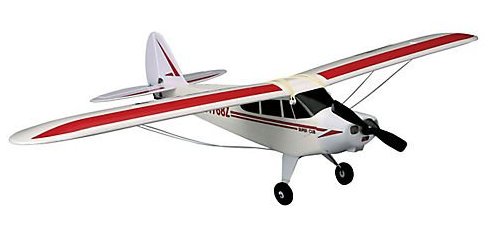
Above: The Super Cub was a popular choice for the tyro RC pilot.
High-wing Trainer Favourites
When an airplane has its wing on top of the fuselage, it's said to be high-wing. Such planes are more stable than low-wingers and so make ideal rc trainers to learn on.
One example that has been widely modelled is the Piper Cub, or variants of. Indeed, one of the biggest selling beginner rc planes in recent years was the Super Cub from HobbyZone®, a brand belonging to North American radio control manufacturer and distributor Horizon Hobby® LLC. Many tyro pilots have cut their teeth on this now iconic trainer!
The original HobbyZone Super Cub has long been discontinued, but it certainly has a place in the rc flying history books as being one of the most popular beginner planes produced.
A slightly smaller, but newer and equally popular version is the Sport Cub S, from the same brand.
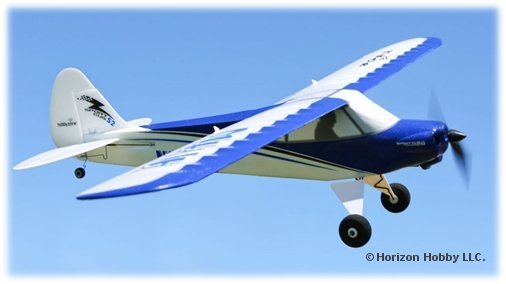
Another hit from HobbyZone, the Sport Cub S2 RTF.
The Sport Cub has already proved to be as popular as the original Super Cub, and features SAFE™ stabilisation technology (more on that later). Definitely a top recommendation for any beginner to the hobby!
Incidentally, Horizon Hobby is a brand I'm happy to recommend simply because I've had many of their products over the years. I can vouch for their quality, value and after-sales support.
Of course there are many other brands out there offering beginner rc planes (FMS, Dynam, Arrows, Ripmax...) which I can also recommend from personal experience, but Horizon has always focused on the beginner with their HobbyZone® range.
Another example is their AeroScout S, a very different 'pod and boom' style airplane:
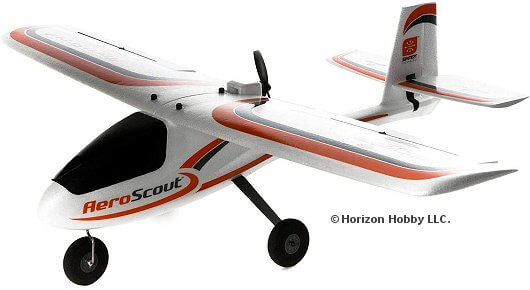
This AeroScout is a distinctly non-scale design plane, which means it isn't based on any real-life plane.
The Sport Cub is a semi-scale plane meaning that it is modelled from a real-life plane (Piper Super Cub) but with a few things simplified. A true scale model airplane means a faithful reproduction of the real thing.
Beginner RC Airplanes: Number of Channels?
The number of channels a radio controlled model has means how many controllable functions there are.
A 3-channel plane will generally have control to motor power, elevator and rudder, although aileron control may be in place of rudder.
A 4-channel plane will have control to motor power, elevator, rudder and ailerons. As you progress through the hobby, the number of channels on your planes will likely increase to include functions such as landing flaps and retractable landing gear.
RC planes can also have just one or two channels, but I would recommend a 3 or 4-channel plane if you're even half-serious about getting in to radio control flying.
You can learn more about channels and rc airplane controls here.
A popular 4-channel trainer is the Apprentice STS™, shown below:
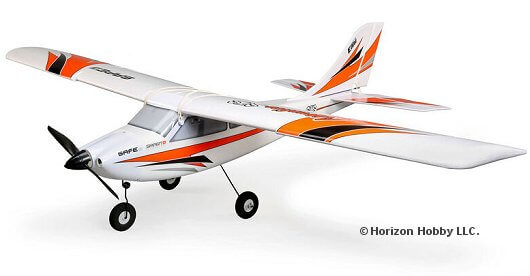
Traditional RC Trainer Alternatives
A classic high wing trainer isn't your only option - a safe alternative is the electric powered glider like this Conscendo® example shown below...
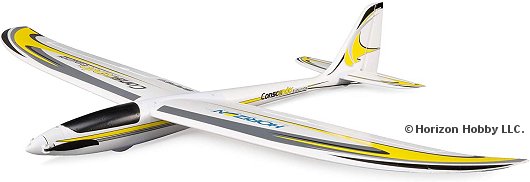
RC powered gliders like this are very stable, giving you plenty of time to react to your control inputs. They are slower and very forgiving aircraft, generally speaking. Perfect for beginner pilots!
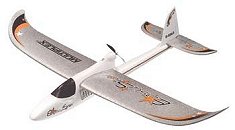 Another type of rc plane ideal for learning to fly with is the 'pusher', like the Multiplex Easy Star shown right.
Another type of rc plane ideal for learning to fly with is the 'pusher', like the Multiplex Easy Star shown right.
Such airplanes are very popular and are a nice alternative to the standard high wing trainer configuration or electric powered glider. Generally speaking they have friendly flight characteristics and are very stable in the air.
Beginner rc airplanes of this configuration are popular with those wanting to use video cameras or FPV (First Person View) equipment, since there is an uninterrupted view over the nose of the plane (i.e. no prop in the way of the camera).
Beginner RC Plane Technology
Our radio control flying hobby has changed a lot in recent years thanks to electronic advancements.
One change, hugely beneficial to (and aimed at) the beginner rc pilot, is the introduction of flight stabilisation technology.
Horizon Hobby pioneered this kind of electronic help for mass-production, with their 'ACT' (Anti-Crash Technology™) used in their earlier beginner planes.
Such electronic wizardry helps prevent a plane from getting in to an undesirable attitude (position in the sky) - a common situation when learning to fly radio control!
More recently the technology has become very advanced and widely available. Horizon's latest version is called SAFE™ (Sensor Assisted Flight Envelope™) technology and now comes as standard in many of their airplanes.
SAFE technology gives the beginner pilot three options - Beginner Mode seriously limits pitch and roll attitudes and offers a self-levelling feature whereby the plane returns to straight and level flight if the transmitter sticks are released to their neutral positions. Intermediate Mode does away with the self-levelling and just reduces the pitch/roll limitations, whilst Experienced Mode just turns all the stabilization aids off and so the plane can be flown without any electronic help.
The SAFE modes are activated/deactivated by a three-way toggle switch on the transmitter.
Plenty of other rc plane manufacturers are also now using similar stabilization technology, and as a result the variety of beginner rc airplane types you can buy is changing.
Take the Eachine micro warbird range, for example. Ridiculously stable in beginner mode, these mini marvels are dead easy to control, and lots of fun too.
I would have given anything for one of these when I was a kid!
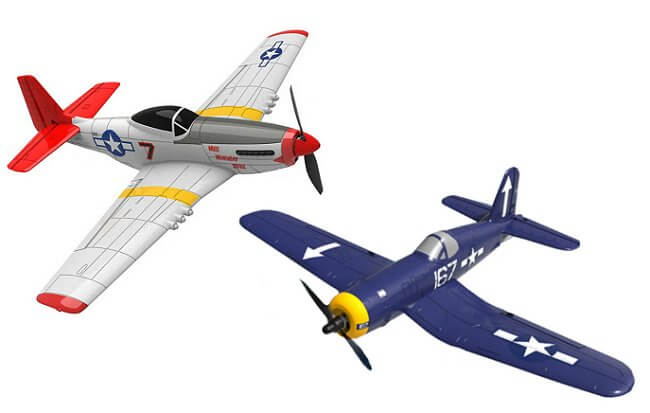
Above: these micro marvels bring rc warbirds into beginner territory!
Another technology is their AS3X™ (Auto Stabilisation 3-Axis™), also now found on many of their model aircraft.
AS3X isn't intended to help the beginner rc pilot, but instead it dampens out unwanted interruptions to the plane's flight path (i.e. mainly from wind gusts). AS3X doesn't actively interfere with the pilot's control inputs as SAFE does, but instead just constantly works away in the background to ensure a smoother flying experience.
These days there are plenty of choices for standalone after-market stabilization gyros. It's not uncommon to see such technology used by pilots regardless of experience and skill.
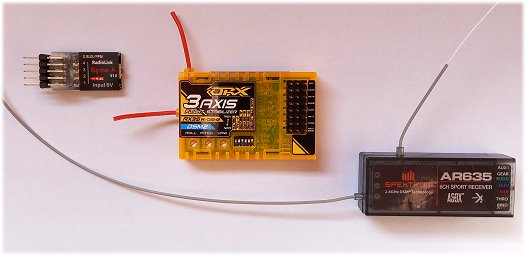
Above: 3 different RC plane stabilization gizmos.
RC airplanes equipped with such technology obviously really help the beginner pilot, especially so if you're going down the self-teach route.
Some argue that the learning is being taken out of learning with this type of technology, and I can see that point of view. But if it helps get someone flying an rc plane safely and in a shorter time, then that's no bad thing in my books!
I suppose the question is will it go too far? Indeed, some beginner rc planes can land themselves at the press of a button. Personally I'm really not a supporter of this, since so much is learned by the pilot at the landing stage of a flight. Take this essential part of training away and the newbie pilot just gets lulled in to a false sense of security, in my opinion.
➤ Part 2: What else makes a good beginner RC airplane?
All the above info is covered in more detail in my Beginner's Guide To Flying RC Airplanes ebook.
